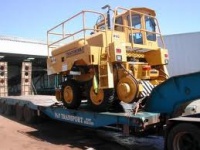Rail Car Movers
Rail Car Movers are road-rail vehicles (capable of travelling on both roads and rail tracks) fitted with couplers for moving small numbers of railroad cars around in a rail siding or small yard. They are extensively used by railroad customers because they are cheaper than owning a switcher locomotive, more convenient and cheaper than paying the railroad operator to do the switching, easier and more productive than manual moving of cars, and in addition they are more versatile since they can travel on road wheels to the cars they need to move, instead of needing clear track.
These car movers offers maneuverability, cost-effective operation, and multi-directional capabilities heretofore unknown in the railroad/rail transit maintenance shop. The expense of purchasing and maintaining large vehicle shunting equipment is virtually eliminated. The Railcar Mover, powered by a 15 HP gasoline, diesel, LPG, or Battery engine utilizes its own weight to develop the required friction on the rail to effect the movement. Hydraulically powered wheels are engaged to start and stop the shunting operation, which can be in either direction. The Railcar Mover is ruggedly designed to provide years of low cost shunting service in your equipment maintenance area.
Typical Principles of Operations
- Pneumatic Center Drive Wheels in the lowered position, the railcar mover is moved under its own power to the track location.
- The railcar mover is positioned on the rails, and the Pneumatic Center Drive Wheels are moved to the raised position.
- The railcar mover is driven into position at the end of the vehicle to be moved.
- If the car is to be moved by the coupler, the car is secured to the railcar mover by means of a custom built mechanical coupler (E Type or transit coupler) or tow bar.
- With the railcar mover in place, the unit can be engaged to move the car in either direction.
Videos
